2025人教版高中英语选择性必修第一册同步练习题--UNIT 4 Part 2 Learning About Language &Using Language(含答案与解析)
文档属性
| 名称 | 2025人教版高中英语选择性必修第一册同步练习题--UNIT 4 Part 2 Learning About Language &Using Language(含答案与解析) | 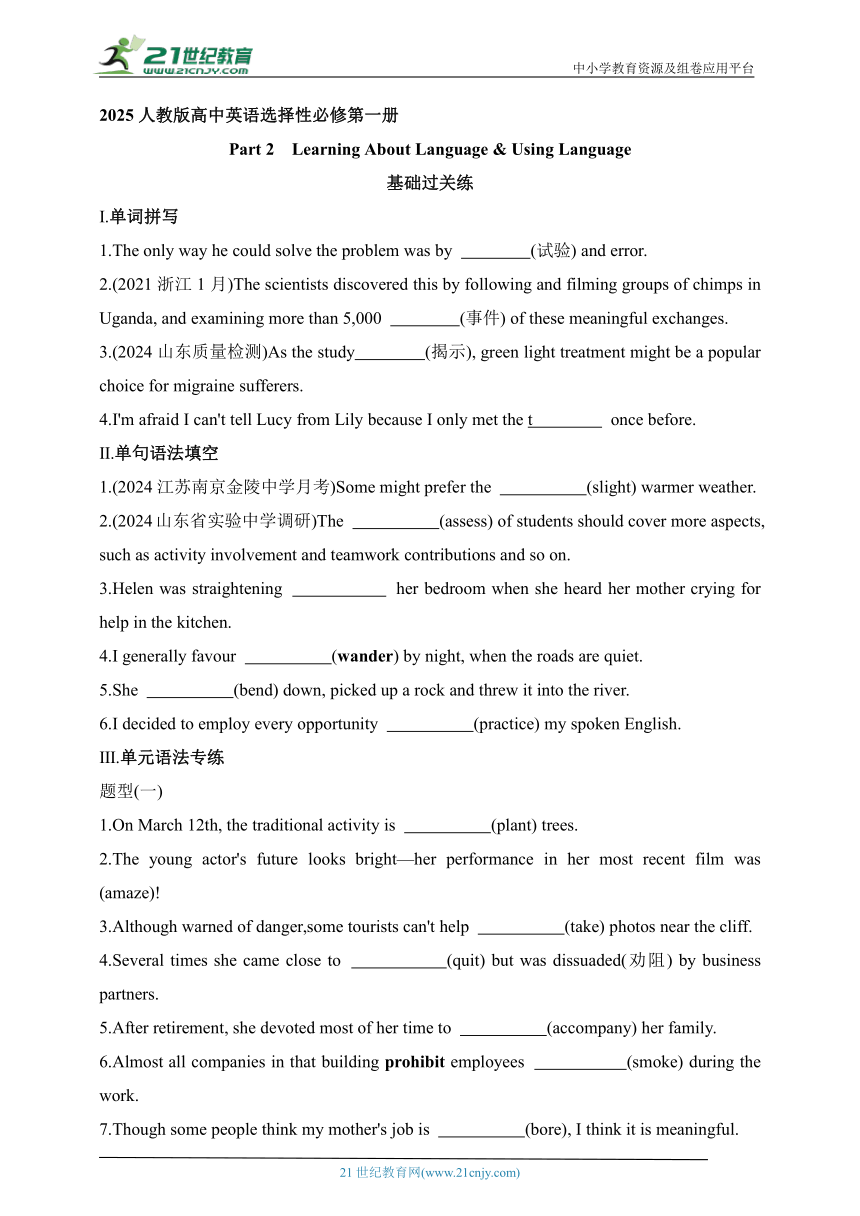 | |
| 格式 | docx | ||
| 文件大小 | 364.1KB | ||
| 资源类型 | 试卷 | ||
| 版本资源 | 人教版(2019) | ||
| 科目 | 英语 | ||
| 更新时间 | 2024-06-05 13:19:23 | ||
图片预览

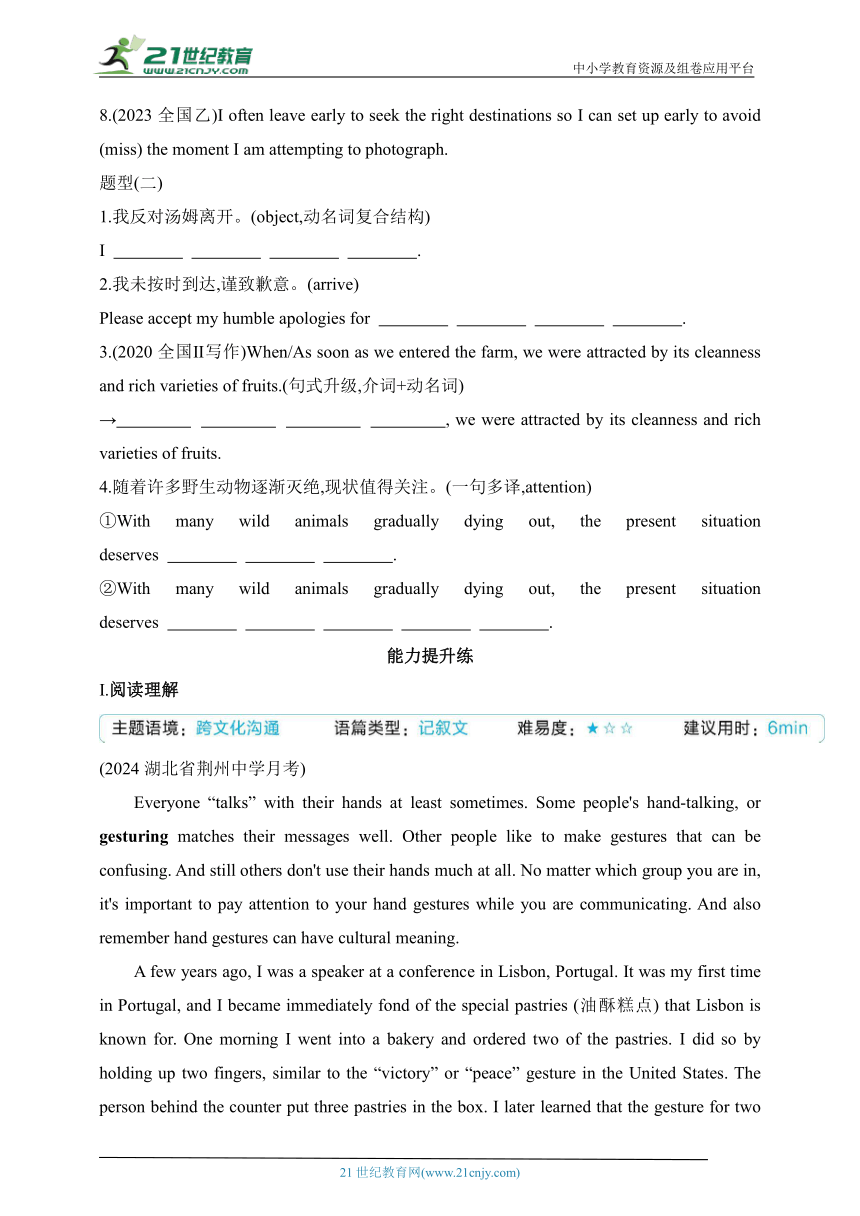
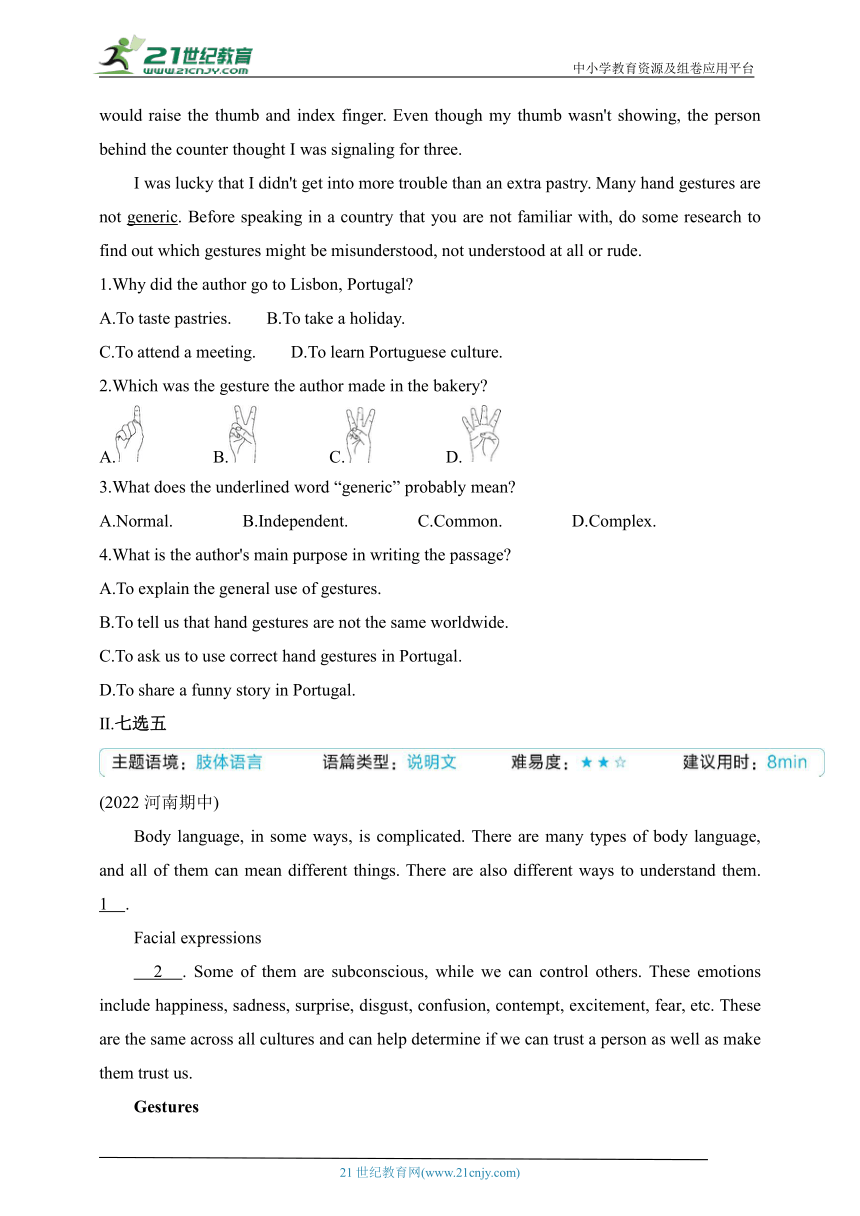
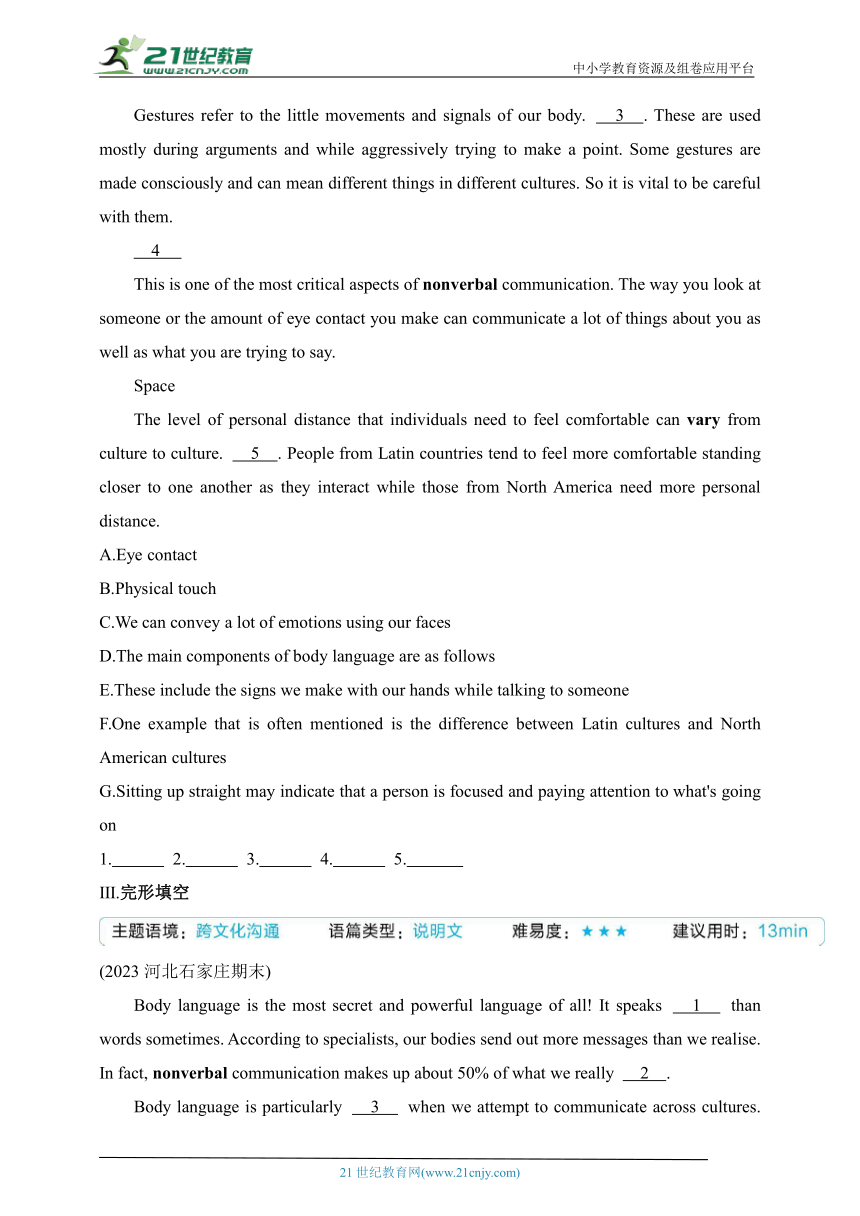
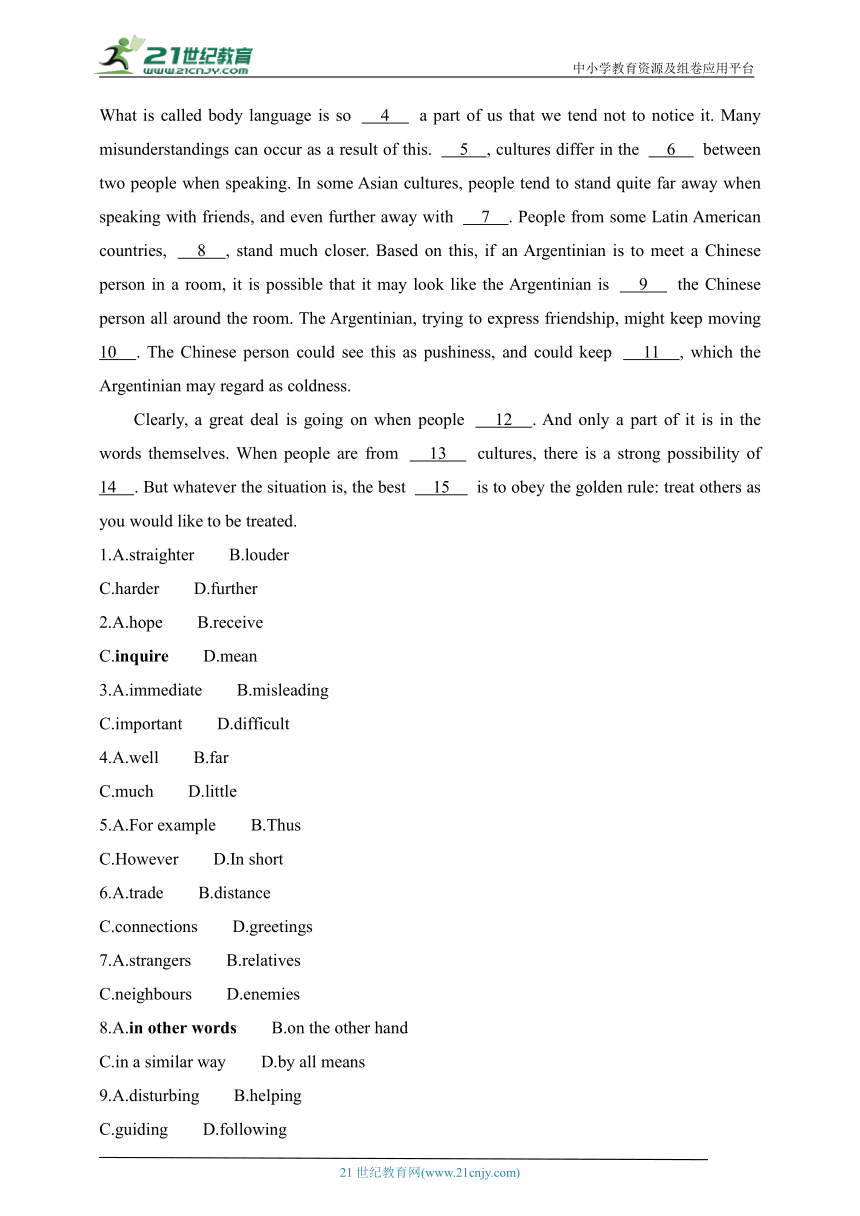
文档简介
中小学教育资源及组卷应用平台
2025人教版高中英语选择性必修第一册
Part 2 Learning About Language & Using Language
基础过关练
Ⅰ.单词拼写
1.The only way he could solve the problem was by (试验) and error.
2.(2021浙江1月)The scientists discovered this by following and filming groups of chimps in Uganda, and examining more than 5,000 (事件) of these meaningful exchanges.
3.(2024山东质量检测)As the study (揭示), green light treatment might be a popular choice for migraine sufferers.
4.I'm afraid I can't tell Lucy from Lily because I only met the t once before.
Ⅱ.单句语法填空
1.(2024江苏南京金陵中学月考)Some might prefer the (slight) warmer weather.
2.(2024山东省实验中学调研)The (assess) of students should cover more aspects, such as activity involvement and teamwork contributions and so on.
3.Helen was straightening her bedroom when she heard her mother crying for help in the kitchen.
4.I generally favour (wander) by night, when the roads are quiet.
5.She (bend) down, picked up a rock and threw it into the river.
6.I decided to employ every opportunity (practice) my spoken English.
Ⅲ.单元语法专练
题型(一)
1.On March 12th, the traditional activity is (plant) trees.
2.The young actor's future looks bright—her performance in her most recent film was (amaze)!
3.Although warned of danger,some tourists can't help (take) photos near the cliff.
4.Several times she came close to (quit) but was dissuaded(劝阻) by business partners.
5.After retirement, she devoted most of her time to (accompany) her family.
6.Almost all companies in that building prohibit employees (smoke) during the work.
7.Though some people think my mother's job is (bore), I think it is meaningful.
8.(2023全国乙)I often leave early to seek the right destinations so I can set up early to avoid (miss) the moment I am attempting to photograph.
题型(二)
1.我反对汤姆离开。(object,动名词复合结构)
I .
2.我未按时到达,谨致歉意。(arrive)
Please accept my humble apologies for .
3.(2020全国Ⅱ写作)When/As soon as we entered the farm, we were attracted by its cleanness and rich varieties of fruits.(句式升级,介词+动名词)
→ , we were attracted by its cleanness and rich varieties of fruits.
4.随着许多野生动物逐渐灭绝,现状值得关注。(一句多译,attention)
①With many wild animals gradually dying out, the present situation deserves .
②With many wild animals gradually dying out, the present situation deserves .
能力提升练
Ⅰ.阅读理解
(2024湖北省荆州中学月考)
Everyone “talks” with their hands at least sometimes. Some people's hand-talking, or gesturing matches their messages well. Other people like to make gestures that can be confusing. And still others don't use their hands much at all. No matter which group you are in, it's important to pay attention to your hand gestures while you are communicating. And also remember hand gestures can have cultural meaning.
A few years ago, I was a speaker at a conference in Lisbon, Portugal. It was my first time in Portugal, and I became immediately fond of the special pastries (油酥糕点) that Lisbon is known for. One morning I went into a bakery and ordered two of the pastries. I did so by holding up two fingers, similar to the “victory” or “peace” gesture in the United States. The person behind the counter put three pastries in the box. I later learned that the gesture for two would raise the thumb and index finger. Even though my thumb wasn't showing, the person behind the counter thought I was signaling for three.
I was lucky that I didn't get into more trouble than an extra pastry. Many hand gestures are not generic. Before speaking in a country that you are not familiar with, do some research to find out which gestures might be misunderstood, not understood at all or rude.
1.Why did the author go to Lisbon, Portugal
A.To taste pastries. B.To take a holiday.
C.To attend a meeting. D.To learn Portuguese culture.
2.Which was the gesture the author made in the bakery
A. B. C. D.
3.What does the underlined word “generic” probably mean
A.Normal. B.Independent. C.Common. D.Complex.
4.What is the author's main purpose in writing the passage
A.To explain the general use of gestures.
B.To tell us that hand gestures are not the same worldwide.
C.To ask us to use correct hand gestures in Portugal.
D.To share a funny story in Portugal.
Ⅱ.七选五
(2022河南期中)
Body language, in some ways, is complicated. There are many types of body language, and all of them can mean different things. There are also different ways to understand them. 1 .
Facial expressions
2 . Some of them are subconscious, while we can control others. These emotions include happiness, sadness, surprise, disgust, confusion, contempt, excitement, fear, etc. These are the same across all cultures and can help determine if we can trust a person as well as make them trust us.
Gestures
Gestures refer to the little movements and signals of our body. 3 . These are used mostly during arguments and while aggressively trying to make a point. Some gestures are made consciously and can mean different things in different cultures. So it is vital to be careful with them.
4
This is one of the most critical aspects of nonverbal communication. The way you look at someone or the amount of eye contact you make can communicate a lot of things about you as well as what you are trying to say.
Space
The level of personal distance that individuals need to feel comfortable can vary from culture to culture. 5 . People from Latin countries tend to feel more comfortable standing closer to one another as they interact while those from North America need more personal distance.
A.Eye contact
B.Physical touch
C.We can convey a lot of emotions using our faces
D.The main components of body language are as follows
E.These include the signs we make with our hands while talking to someone
F.One example that is often mentioned is the difference between Latin cultures and North American cultures
G.Sitting up straight may indicate that a person is focused and paying attention to what's going on
1. 2. 3. 4. 5.
Ⅲ.完形填空
(2023河北石家庄期末)
Body language is the most secret and powerful language of all! It speaks 1 than words sometimes. According to specialists, our bodies send out more messages than we realise. In fact, nonverbal communication makes up about 50% of what we really 2 .
Body language is particularly 3 when we attempt to communicate across cultures. What is called body language is so 4 a part of us that we tend not to notice it. Many misunderstandings can occur as a result of this. 5 , cultures differ in the 6 between two people when speaking. In some Asian cultures, people tend to stand quite far away when speaking with friends, and even further away with 7 . People from some Latin American countries, 8 , stand much closer. Based on this, if an Argentinian is to meet a Chinese person in a room, it is possible that it may look like the Argentinian is 9 the Chinese person all around the room. The Argentinian, trying to express friendship, might keep moving 10 . The Chinese person could see this as pushiness, and could keep 11 , which the Argentinian may regard as coldness.
Clearly, a great deal is going on when people 12 . And only a part of it is in the words themselves. When people are from 13 cultures, there is a strong possibility of 14 . But whatever the situation is, the best 15 is to obey the golden rule: treat others as you would like to be treated.
1.A.straighter B.louder
C.harder D.further
2.A.hope B.receive
C.inquire D.mean
3.A.immediate B.misleading
C.important D.difficult
4.A.well B.far
C.much D.little
5.A.For example B.Thus
C.However D.In short
6.A.trade B.distance
C.connections D.greetings
7.A.strangers B.relatives
C.neighbours D.enemies
8.A.in other words B.on the other hand
C.in a similar way D.by all means
9.A.disturbing B.helping
C.guiding D.following
10.A.closer B.faster
C.further D.slower
11.A.stepping forward B.going on
C.backing away D.coming out
12.A.talk B.travel
C.laugh D.think
13.A.different B.appropriate
C.internal D.fake
14.A.curiosity B.excitement
C.misunderstanding D.nervousness
15.A.chance B.time
C.result D.advice
答案与分层梯度式解析
Part 2 Learning About Language &Using Language
基础过关练
Ⅰ.1.trial 2.incidents 3.reveals 4.twins
Ⅱ.1.slightly 考查副词。空处修饰形容词warmer,作状语,用副词形式,表示“稍微;略微”,故填slightly。句意:有些人可能更喜欢稍微温暖一点的天气。
2.assessment 考查名词。此处是“the...of...”结构,在句中作主语,设空处应用名词形式。assessment评估;评定。句意:对学生的评估应该涵盖更多的层面,比如活动参与度、团队合作贡献等。
3.up 考查固定搭配。straighten up整理; 收拾整齐,为固定搭配。故填up。
4.wandering 考查动名词作宾语。设空处在句中作动词favour的宾语,favour后可接动名词作宾语,又因为是主动,故填wandering。
5.bent 考查时态。句中and连接三个并列的谓语动词,由另外两个谓语动词的时态可知此处应用一般过去时。故填bent。句意:她弯下腰,捡起一块石头,然后把它扔进河里。
6.to practice 考查动词不定式。employ sth. to do sth.意为“利用某物来做某事”。故填to practice。句意:我决定利用一切机会来练习英语口语。
Ⅲ.题型(一)
1.planting 考查动名词作表语。设空处说明主语the traditional activity的内容,为抽象概念,应用动名词形式作表语。故填planting。句意:3月12日,传统的活动是植树。
2.amazing 考查现在分词作表语。设空处在句中充当表语,用来说明事物(performance)的性质、特征等,表示“令人惊叹的”,所以填amazing。
3.taking 考查动名词作宾语。can't help doing sth.意为“情不自禁地做某事”。故填taking。句意:尽管被警告有危险,但有些游客还是忍不住在悬崖附近拍照。
4.quitting 考查动名词作宾语。come close to doing sth.意为“差一点做某事”,to是介词,后接动名词作宾语,故填quitting。
5.accompanying 考查动名词作宾语。devote time to doing sth.意为“花时间做某事”,to为介词,后接动名词作宾语,故填accompanying。句意:退休后,她把大部分时间都花在陪伴家人上。
6.smoking 考查动名词作宾语。prohibit sb. doing sth.意为“禁止某人做某事”。故填smoking。句意:在那栋大楼里,几乎所有的公司都禁止员工在工作期间抽烟。
7.boring 考查现在分词作表语。设空处在句中充当表语,用来说明事物(job)的性质、特征等,表示“乏味的”,所以填boring。
8.missing 考查动名词作宾语。avoid doing sth.意为“避免做某事”。故填missing。句意:我经常早早出发,寻找合适的目的地,这样我就可以早点调试好设备,以避免错过我试图拍摄的那一刻。
题型(二)
1.object(ed) to Tom's leaving 2.not arriving on time 3.Upon/On entering the farm 4.①paying attention to ②to be paid attention to
能力提升练
Ⅰ.◎语篇解读 本文是一篇记叙文。作者在葡萄牙的里斯本的一个面包店里的经历让他明白:世界上许多手势的意义并不相同,并体现文化意义。
1.C 细节理解题。根据第二段第一句“A few years ago, I was a speaker at a conference in Lisbon, Portugal.”可知,作者是为了开会才去葡萄牙的里斯本的。故选C。
2.B 细节理解题。根据第二段第四句“I did so by holding up two fingers, similar to the ‘victory’ or ‘peace’ gesture in the United States.”可知,作者在面包店所做的手势是“举起两根手指”,即图B所示。故选B。
3.C 词义猜测题。画线词所在句意为“很多手势并不是 ”。根据画线词后的“Before speaking in a country that you are not familiar with, do some research to find out which gestures might be misunderstood, not understood at all or rude.”可知,不同的国家对手势的理解可能是不同的,有的手势会引起误解或者完全不被理解,由此可推知画线处所在句想要表达的是:很多手势并不是共有/通用的。generic与C选项common意思相近。故选C。
4.B 推理判断题。通读全文内容可知,第一段提到手势的重要性以及手势体现文化意义;第二段提到的例子说明同样的手势在不同的区域理解不同;最后一段中的最后一句进行总结,点明在一个你不熟悉的国家说话之前,做一些调查,弄清楚哪些手势可能会被误解、根本不被理解或是粗鲁的,由此推知,作者试图告诉我们的是:不同国家对手势的理解可能是不同的,所以说手势在世界各地是不一样的。故选B。
【高频词汇】 1.pay attention to注意 2.get into trouble陷入困境 3.be familiar with对……熟悉
长难句
原句 Before speaking in a country that you are not familiar with, do some research to find out which gestures might be misunderstood, not understood at all or rude.
分析 本句是一个主从复合句。介词短语Before speaking...作时间状语,其中that引导定语从句修饰 country;主句为祈使句;find out 后的which引导宾语从句。
译文 在一个你不熟悉的国家说话之前,要先做一些研究,弄清楚哪些手势可能被误解、根本不被理解或是粗鲁无礼的。
Ⅱ.◎语篇解读 本文是一篇说明文。文章介绍了不同的身体语言表达的不同意思。
1.D 过渡句。空前句提到“也有不同的方法来理解它们”,由下文的几个小标题可知下文介绍了几种不同的身体语言,D项 (身体语言的主要组成部分如下)承接上文并引出下文。
2.C 细节句。本段小标题说的是面部表情,空后提到“它们有些是潜意识的,而我们可以控制其他的。这些情绪包括……”,C项 (我们可以用我们的面部表情传递很多情绪)符合小标题所说的内容,同时可以引出下文。故选C。
3.E 细节句。空前句提到“姿势指的是我们身体的小动作和信号”,E项 (这些包括我们在和别人说话时用手做的示意动作)也是在向我们解释姿势,符合语境。
4.A 主旨句。设空处为本段的小标题,本段主要说的是眼神交流。故选A。
5.F 细节句。最后一个身体语言说的是“空间距离”,空后提到“来自拉丁国家的人在互动时,彼此站得更近往往会感觉更舒服,而那些来自北美的人则需要更多的个人距离”,F项 (一个经常提到的例子是拉丁文化和北美文化之间的差异)符合语境,可以引出下文。故选F。
【高频词汇】 1.complicated adj.复杂的 2.confusion n.困惑 3.refer to 指的是 4.vital adj.至关重要的
5.critical adj.关键的;批评的 6.interact v.交流;相互影响
【差距词汇】 1.disgust n.厌恶;憎恶 2.contempt n.蔑视
Ⅲ.◎语篇解读 本文是一篇说明文。作者以中国人和阿根廷人为例进行了阐述,介绍了在进行跨文化交流过程中,肢体语言的差异。
1.B 由上文“Body language is the most secret and powerful language of all!”可知,肢体语言是所有语言中最神秘和最强大的。所以说肢体语言有时要比言语发声更响亮。A.更直接地;B.更大声地;C.更努力地;D.更远。故选B。
2.D 根据上文的“our bodies send out more messages than we realise”可知,我们的身体传达的信息比我们意识到的更多,所以这里指非言语交流占我们真正表达的意思的50%左右。A.希望;B.收到;C.询问;D.意思是。故选D。
3.C 根据设空处后的“when we attempt to communicate across cultures”并结合常识可知,跨文化交流时,语言不同,通过肢体语言可以达成交流的目的,所以这里指肢体语言尤为重要。A.立即的;B.误导的;C.重要的;D.困难的。故选C。
4.C 根据上文提及的肢体语言的重要性可知,这里指“肢体语言是我们很大的一部分,以至于我们往往关注不到它”。so much a part of...表示“……很大的一部分”,故选C。
5.A 上句谈到忽视肢体语言会产生很多误解,下文以一些亚洲人和一些拉丁美洲人说话时的站立距离进行举例,对上文进行了诠释。所以此处是举例。A.例如;B.因此;C.然而;D.简而言之。故选A。
6.B 根据下文的“stand quite far away”“even further away”“stand much closer”可推知,下文描述不同地区人们说话时站的距离远近。A.贸易;B.距离;C.联系;D.问候。故选B。
7.A 空前谈到在一些亚洲文化中,人们和朋友交谈时往往站得很远,结合空前的“even further away”和常识可推知,空处表示的内容与friends相比亲密度要差一些,结合选项可知 A项(陌生人)符合语境。B.亲戚;C.邻居;D.敌人。故选A。易错归因 本题易误选D项,原因在于D项(敌人)相比A项(陌生人)在关系上更加疏远,但D项有点“用力过猛”,这里在讲与不同人谈话时的距离,朋友和陌生人是日常谈话中最常见的两个对象,这里没必要上升到敌人的程度。
8.B 上文提到一些亚洲国家的人在交谈时站得很远,设空处所在句介绍一些拉丁美洲国家的人站得近得多。故推知,这种情况与上文相比是“另一方面”的情况。A.换句话说;B.另一方面;C.以相似的方式;D.当然。故选B。
9.D 根据常识可知,阿根廷人属于拉丁美洲人。根据上文可知,拉丁美洲人在与人交流时站的距离较近,而中国人属于亚洲人,他们在与人交流时站的距离较远,想要保持距离。所以如果阿根廷人遇到中国人,在交谈时看起来就像这个阿根廷人在房间里跟着这个中国人到处走。A.打扰;B.帮助;C.指导;D.跟随。故选D。
10.A 根据上文“People from some Latin American countries, 8 , stand much closer.”以及空前的“trying to express friendship”可推知,想要表达友好的阿根廷人交谈时可能会不断靠近。A.更靠近;B. 更快地;C.更远地;D.更慢地。故选A。
11.C 上一句谈到想要表达友好的阿根廷人交谈时可能会不断靠近,而中国人交谈时习惯保持距离,所以看到对方不断靠近则会不断后退。A.向前走;B.继续;C.后退;D.出版。故选C。
12.A 根据上文介绍的交流时所发生的肢体语言可推知,此处应指谈话时,许多事情都在发生。A.谈论,谈话;B.旅行;C.笑;D.思考。故选A。
13.A 由上文作者给出的由于文化不同而导致误解的例子可推知,这里指“当人们来自不同的文化”。 A.不同的;B.合适的;C.内部的;D.假的。故选A。
14.C 根据上文提到不同国家的人交流时肢体语言存在的差异可推知,当人们来自不同的文化背景时,产生误解的可能性会很大。A.好奇;B.兴奋,激动;C.误解;D.紧张。故选C。
15.D 根据空后的“treat others as you would like to be treated”可推知,这应该是针对跨文化交流时的建议。A.机会;B.时间;C.结果;D.建议。故选D。
【高频词汇】 1.send out发出 2.make up组成;构成;编造;补上 3.attempt vt.企图;试图;尝试 4.as a result of由于 5.regard...as...把……视为……
长难句
原句 Based on this, if an Argentinian is to meet a Chinese person in a room, it is possible that it may look like the Argentinian is following the Chinese person all around the room.
分析 本句是一个主从复合句。过去分词短语Based on...作状语;if引导条件状语从句;主句中it作形式主语,真正的主语是that引导的从句。look后的like引导表语从句。
译文 基于此,如果一个阿根廷人在房间里遇到一个中国人,很可能看起来阿根廷人在房间里跟着中国人到处走。
21世纪教育网 www.21cnjy.com 精品试卷·第 2 页 (共 2 页)
21世纪教育网(www.21cnjy.com)
2025人教版高中英语选择性必修第一册
Part 2 Learning About Language & Using Language
基础过关练
Ⅰ.单词拼写
1.The only way he could solve the problem was by (试验) and error.
2.(2021浙江1月)The scientists discovered this by following and filming groups of chimps in Uganda, and examining more than 5,000 (事件) of these meaningful exchanges.
3.(2024山东质量检测)As the study (揭示), green light treatment might be a popular choice for migraine sufferers.
4.I'm afraid I can't tell Lucy from Lily because I only met the t once before.
Ⅱ.单句语法填空
1.(2024江苏南京金陵中学月考)Some might prefer the (slight) warmer weather.
2.(2024山东省实验中学调研)The (assess) of students should cover more aspects, such as activity involvement and teamwork contributions and so on.
3.Helen was straightening her bedroom when she heard her mother crying for help in the kitchen.
4.I generally favour (wander) by night, when the roads are quiet.
5.She (bend) down, picked up a rock and threw it into the river.
6.I decided to employ every opportunity (practice) my spoken English.
Ⅲ.单元语法专练
题型(一)
1.On March 12th, the traditional activity is (plant) trees.
2.The young actor's future looks bright—her performance in her most recent film was (amaze)!
3.Although warned of danger,some tourists can't help (take) photos near the cliff.
4.Several times she came close to (quit) but was dissuaded(劝阻) by business partners.
5.After retirement, she devoted most of her time to (accompany) her family.
6.Almost all companies in that building prohibit employees (smoke) during the work.
7.Though some people think my mother's job is (bore), I think it is meaningful.
8.(2023全国乙)I often leave early to seek the right destinations so I can set up early to avoid (miss) the moment I am attempting to photograph.
题型(二)
1.我反对汤姆离开。(object,动名词复合结构)
I .
2.我未按时到达,谨致歉意。(arrive)
Please accept my humble apologies for .
3.(2020全国Ⅱ写作)When/As soon as we entered the farm, we were attracted by its cleanness and rich varieties of fruits.(句式升级,介词+动名词)
→ , we were attracted by its cleanness and rich varieties of fruits.
4.随着许多野生动物逐渐灭绝,现状值得关注。(一句多译,attention)
①With many wild animals gradually dying out, the present situation deserves .
②With many wild animals gradually dying out, the present situation deserves .
能力提升练
Ⅰ.阅读理解
(2024湖北省荆州中学月考)
Everyone “talks” with their hands at least sometimes. Some people's hand-talking, or gesturing matches their messages well. Other people like to make gestures that can be confusing. And still others don't use their hands much at all. No matter which group you are in, it's important to pay attention to your hand gestures while you are communicating. And also remember hand gestures can have cultural meaning.
A few years ago, I was a speaker at a conference in Lisbon, Portugal. It was my first time in Portugal, and I became immediately fond of the special pastries (油酥糕点) that Lisbon is known for. One morning I went into a bakery and ordered two of the pastries. I did so by holding up two fingers, similar to the “victory” or “peace” gesture in the United States. The person behind the counter put three pastries in the box. I later learned that the gesture for two would raise the thumb and index finger. Even though my thumb wasn't showing, the person behind the counter thought I was signaling for three.
I was lucky that I didn't get into more trouble than an extra pastry. Many hand gestures are not generic. Before speaking in a country that you are not familiar with, do some research to find out which gestures might be misunderstood, not understood at all or rude.
1.Why did the author go to Lisbon, Portugal
A.To taste pastries. B.To take a holiday.
C.To attend a meeting. D.To learn Portuguese culture.
2.Which was the gesture the author made in the bakery
A. B. C. D.
3.What does the underlined word “generic” probably mean
A.Normal. B.Independent. C.Common. D.Complex.
4.What is the author's main purpose in writing the passage
A.To explain the general use of gestures.
B.To tell us that hand gestures are not the same worldwide.
C.To ask us to use correct hand gestures in Portugal.
D.To share a funny story in Portugal.
Ⅱ.七选五
(2022河南期中)
Body language, in some ways, is complicated. There are many types of body language, and all of them can mean different things. There are also different ways to understand them. 1 .
Facial expressions
2 . Some of them are subconscious, while we can control others. These emotions include happiness, sadness, surprise, disgust, confusion, contempt, excitement, fear, etc. These are the same across all cultures and can help determine if we can trust a person as well as make them trust us.
Gestures
Gestures refer to the little movements and signals of our body. 3 . These are used mostly during arguments and while aggressively trying to make a point. Some gestures are made consciously and can mean different things in different cultures. So it is vital to be careful with them.
4
This is one of the most critical aspects of nonverbal communication. The way you look at someone or the amount of eye contact you make can communicate a lot of things about you as well as what you are trying to say.
Space
The level of personal distance that individuals need to feel comfortable can vary from culture to culture. 5 . People from Latin countries tend to feel more comfortable standing closer to one another as they interact while those from North America need more personal distance.
A.Eye contact
B.Physical touch
C.We can convey a lot of emotions using our faces
D.The main components of body language are as follows
E.These include the signs we make with our hands while talking to someone
F.One example that is often mentioned is the difference between Latin cultures and North American cultures
G.Sitting up straight may indicate that a person is focused and paying attention to what's going on
1. 2. 3. 4. 5.
Ⅲ.完形填空
(2023河北石家庄期末)
Body language is the most secret and powerful language of all! It speaks 1 than words sometimes. According to specialists, our bodies send out more messages than we realise. In fact, nonverbal communication makes up about 50% of what we really 2 .
Body language is particularly 3 when we attempt to communicate across cultures. What is called body language is so 4 a part of us that we tend not to notice it. Many misunderstandings can occur as a result of this. 5 , cultures differ in the 6 between two people when speaking. In some Asian cultures, people tend to stand quite far away when speaking with friends, and even further away with 7 . People from some Latin American countries, 8 , stand much closer. Based on this, if an Argentinian is to meet a Chinese person in a room, it is possible that it may look like the Argentinian is 9 the Chinese person all around the room. The Argentinian, trying to express friendship, might keep moving 10 . The Chinese person could see this as pushiness, and could keep 11 , which the Argentinian may regard as coldness.
Clearly, a great deal is going on when people 12 . And only a part of it is in the words themselves. When people are from 13 cultures, there is a strong possibility of 14 . But whatever the situation is, the best 15 is to obey the golden rule: treat others as you would like to be treated.
1.A.straighter B.louder
C.harder D.further
2.A.hope B.receive
C.inquire D.mean
3.A.immediate B.misleading
C.important D.difficult
4.A.well B.far
C.much D.little
5.A.For example B.Thus
C.However D.In short
6.A.trade B.distance
C.connections D.greetings
7.A.strangers B.relatives
C.neighbours D.enemies
8.A.in other words B.on the other hand
C.in a similar way D.by all means
9.A.disturbing B.helping
C.guiding D.following
10.A.closer B.faster
C.further D.slower
11.A.stepping forward B.going on
C.backing away D.coming out
12.A.talk B.travel
C.laugh D.think
13.A.different B.appropriate
C.internal D.fake
14.A.curiosity B.excitement
C.misunderstanding D.nervousness
15.A.chance B.time
C.result D.advice
答案与分层梯度式解析
Part 2 Learning About Language &Using Language
基础过关练
Ⅰ.1.trial 2.incidents 3.reveals 4.twins
Ⅱ.1.slightly 考查副词。空处修饰形容词warmer,作状语,用副词形式,表示“稍微;略微”,故填slightly。句意:有些人可能更喜欢稍微温暖一点的天气。
2.assessment 考查名词。此处是“the...of...”结构,在句中作主语,设空处应用名词形式。assessment评估;评定。句意:对学生的评估应该涵盖更多的层面,比如活动参与度、团队合作贡献等。
3.up 考查固定搭配。straighten up整理; 收拾整齐,为固定搭配。故填up。
4.wandering 考查动名词作宾语。设空处在句中作动词favour的宾语,favour后可接动名词作宾语,又因为是主动,故填wandering。
5.bent 考查时态。句中and连接三个并列的谓语动词,由另外两个谓语动词的时态可知此处应用一般过去时。故填bent。句意:她弯下腰,捡起一块石头,然后把它扔进河里。
6.to practice 考查动词不定式。employ sth. to do sth.意为“利用某物来做某事”。故填to practice。句意:我决定利用一切机会来练习英语口语。
Ⅲ.题型(一)
1.planting 考查动名词作表语。设空处说明主语the traditional activity的内容,为抽象概念,应用动名词形式作表语。故填planting。句意:3月12日,传统的活动是植树。
2.amazing 考查现在分词作表语。设空处在句中充当表语,用来说明事物(performance)的性质、特征等,表示“令人惊叹的”,所以填amazing。
3.taking 考查动名词作宾语。can't help doing sth.意为“情不自禁地做某事”。故填taking。句意:尽管被警告有危险,但有些游客还是忍不住在悬崖附近拍照。
4.quitting 考查动名词作宾语。come close to doing sth.意为“差一点做某事”,to是介词,后接动名词作宾语,故填quitting。
5.accompanying 考查动名词作宾语。devote time to doing sth.意为“花时间做某事”,to为介词,后接动名词作宾语,故填accompanying。句意:退休后,她把大部分时间都花在陪伴家人上。
6.smoking 考查动名词作宾语。prohibit sb. doing sth.意为“禁止某人做某事”。故填smoking。句意:在那栋大楼里,几乎所有的公司都禁止员工在工作期间抽烟。
7.boring 考查现在分词作表语。设空处在句中充当表语,用来说明事物(job)的性质、特征等,表示“乏味的”,所以填boring。
8.missing 考查动名词作宾语。avoid doing sth.意为“避免做某事”。故填missing。句意:我经常早早出发,寻找合适的目的地,这样我就可以早点调试好设备,以避免错过我试图拍摄的那一刻。
题型(二)
1.object(ed) to Tom's leaving 2.not arriving on time 3.Upon/On entering the farm 4.①paying attention to ②to be paid attention to
能力提升练
Ⅰ.◎语篇解读 本文是一篇记叙文。作者在葡萄牙的里斯本的一个面包店里的经历让他明白:世界上许多手势的意义并不相同,并体现文化意义。
1.C 细节理解题。根据第二段第一句“A few years ago, I was a speaker at a conference in Lisbon, Portugal.”可知,作者是为了开会才去葡萄牙的里斯本的。故选C。
2.B 细节理解题。根据第二段第四句“I did so by holding up two fingers, similar to the ‘victory’ or ‘peace’ gesture in the United States.”可知,作者在面包店所做的手势是“举起两根手指”,即图B所示。故选B。
3.C 词义猜测题。画线词所在句意为“很多手势并不是 ”。根据画线词后的“Before speaking in a country that you are not familiar with, do some research to find out which gestures might be misunderstood, not understood at all or rude.”可知,不同的国家对手势的理解可能是不同的,有的手势会引起误解或者完全不被理解,由此可推知画线处所在句想要表达的是:很多手势并不是共有/通用的。generic与C选项common意思相近。故选C。
4.B 推理判断题。通读全文内容可知,第一段提到手势的重要性以及手势体现文化意义;第二段提到的例子说明同样的手势在不同的区域理解不同;最后一段中的最后一句进行总结,点明在一个你不熟悉的国家说话之前,做一些调查,弄清楚哪些手势可能会被误解、根本不被理解或是粗鲁的,由此推知,作者试图告诉我们的是:不同国家对手势的理解可能是不同的,所以说手势在世界各地是不一样的。故选B。
【高频词汇】 1.pay attention to注意 2.get into trouble陷入困境 3.be familiar with对……熟悉
长难句
原句 Before speaking in a country that you are not familiar with, do some research to find out which gestures might be misunderstood, not understood at all or rude.
分析 本句是一个主从复合句。介词短语Before speaking...作时间状语,其中that引导定语从句修饰 country;主句为祈使句;find out 后的which引导宾语从句。
译文 在一个你不熟悉的国家说话之前,要先做一些研究,弄清楚哪些手势可能被误解、根本不被理解或是粗鲁无礼的。
Ⅱ.◎语篇解读 本文是一篇说明文。文章介绍了不同的身体语言表达的不同意思。
1.D 过渡句。空前句提到“也有不同的方法来理解它们”,由下文的几个小标题可知下文介绍了几种不同的身体语言,D项 (身体语言的主要组成部分如下)承接上文并引出下文。
2.C 细节句。本段小标题说的是面部表情,空后提到“它们有些是潜意识的,而我们可以控制其他的。这些情绪包括……”,C项 (我们可以用我们的面部表情传递很多情绪)符合小标题所说的内容,同时可以引出下文。故选C。
3.E 细节句。空前句提到“姿势指的是我们身体的小动作和信号”,E项 (这些包括我们在和别人说话时用手做的示意动作)也是在向我们解释姿势,符合语境。
4.A 主旨句。设空处为本段的小标题,本段主要说的是眼神交流。故选A。
5.F 细节句。最后一个身体语言说的是“空间距离”,空后提到“来自拉丁国家的人在互动时,彼此站得更近往往会感觉更舒服,而那些来自北美的人则需要更多的个人距离”,F项 (一个经常提到的例子是拉丁文化和北美文化之间的差异)符合语境,可以引出下文。故选F。
【高频词汇】 1.complicated adj.复杂的 2.confusion n.困惑 3.refer to 指的是 4.vital adj.至关重要的
5.critical adj.关键的;批评的 6.interact v.交流;相互影响
【差距词汇】 1.disgust n.厌恶;憎恶 2.contempt n.蔑视
Ⅲ.◎语篇解读 本文是一篇说明文。作者以中国人和阿根廷人为例进行了阐述,介绍了在进行跨文化交流过程中,肢体语言的差异。
1.B 由上文“Body language is the most secret and powerful language of all!”可知,肢体语言是所有语言中最神秘和最强大的。所以说肢体语言有时要比言语发声更响亮。A.更直接地;B.更大声地;C.更努力地;D.更远。故选B。
2.D 根据上文的“our bodies send out more messages than we realise”可知,我们的身体传达的信息比我们意识到的更多,所以这里指非言语交流占我们真正表达的意思的50%左右。A.希望;B.收到;C.询问;D.意思是。故选D。
3.C 根据设空处后的“when we attempt to communicate across cultures”并结合常识可知,跨文化交流时,语言不同,通过肢体语言可以达成交流的目的,所以这里指肢体语言尤为重要。A.立即的;B.误导的;C.重要的;D.困难的。故选C。
4.C 根据上文提及的肢体语言的重要性可知,这里指“肢体语言是我们很大的一部分,以至于我们往往关注不到它”。so much a part of...表示“……很大的一部分”,故选C。
5.A 上句谈到忽视肢体语言会产生很多误解,下文以一些亚洲人和一些拉丁美洲人说话时的站立距离进行举例,对上文进行了诠释。所以此处是举例。A.例如;B.因此;C.然而;D.简而言之。故选A。
6.B 根据下文的“stand quite far away”“even further away”“stand much closer”可推知,下文描述不同地区人们说话时站的距离远近。A.贸易;B.距离;C.联系;D.问候。故选B。
7.A 空前谈到在一些亚洲文化中,人们和朋友交谈时往往站得很远,结合空前的“even further away”和常识可推知,空处表示的内容与friends相比亲密度要差一些,结合选项可知 A项(陌生人)符合语境。B.亲戚;C.邻居;D.敌人。故选A。易错归因 本题易误选D项,原因在于D项(敌人)相比A项(陌生人)在关系上更加疏远,但D项有点“用力过猛”,这里在讲与不同人谈话时的距离,朋友和陌生人是日常谈话中最常见的两个对象,这里没必要上升到敌人的程度。
8.B 上文提到一些亚洲国家的人在交谈时站得很远,设空处所在句介绍一些拉丁美洲国家的人站得近得多。故推知,这种情况与上文相比是“另一方面”的情况。A.换句话说;B.另一方面;C.以相似的方式;D.当然。故选B。
9.D 根据常识可知,阿根廷人属于拉丁美洲人。根据上文可知,拉丁美洲人在与人交流时站的距离较近,而中国人属于亚洲人,他们在与人交流时站的距离较远,想要保持距离。所以如果阿根廷人遇到中国人,在交谈时看起来就像这个阿根廷人在房间里跟着这个中国人到处走。A.打扰;B.帮助;C.指导;D.跟随。故选D。
10.A 根据上文“People from some Latin American countries, 8 , stand much closer.”以及空前的“trying to express friendship”可推知,想要表达友好的阿根廷人交谈时可能会不断靠近。A.更靠近;B. 更快地;C.更远地;D.更慢地。故选A。
11.C 上一句谈到想要表达友好的阿根廷人交谈时可能会不断靠近,而中国人交谈时习惯保持距离,所以看到对方不断靠近则会不断后退。A.向前走;B.继续;C.后退;D.出版。故选C。
12.A 根据上文介绍的交流时所发生的肢体语言可推知,此处应指谈话时,许多事情都在发生。A.谈论,谈话;B.旅行;C.笑;D.思考。故选A。
13.A 由上文作者给出的由于文化不同而导致误解的例子可推知,这里指“当人们来自不同的文化”。 A.不同的;B.合适的;C.内部的;D.假的。故选A。
14.C 根据上文提到不同国家的人交流时肢体语言存在的差异可推知,当人们来自不同的文化背景时,产生误解的可能性会很大。A.好奇;B.兴奋,激动;C.误解;D.紧张。故选C。
15.D 根据空后的“treat others as you would like to be treated”可推知,这应该是针对跨文化交流时的建议。A.机会;B.时间;C.结果;D.建议。故选D。
【高频词汇】 1.send out发出 2.make up组成;构成;编造;补上 3.attempt vt.企图;试图;尝试 4.as a result of由于 5.regard...as...把……视为……
长难句
原句 Based on this, if an Argentinian is to meet a Chinese person in a room, it is possible that it may look like the Argentinian is following the Chinese person all around the room.
分析 本句是一个主从复合句。过去分词短语Based on...作状语;if引导条件状语从句;主句中it作形式主语,真正的主语是that引导的从句。look后的like引导表语从句。
译文 基于此,如果一个阿根廷人在房间里遇到一个中国人,很可能看起来阿根廷人在房间里跟着中国人到处走。
21世纪教育网 www.21cnjy.com 精品试卷·第 2 页 (共 2 页)
21世纪教育网(www.21cnjy.com)
